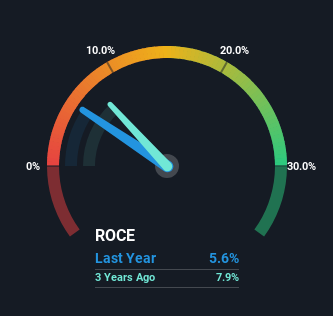Capital Allocation Trends At AMD Industries (NSE:AMDIND) Aren't Ideal
To find a multi-bagger stock, what are the underlying trends we should look for in a business? One common approach is to try and find a company with returns on capital employed (ROCE) that are increasing, in conjunction with a growing amount of capital employed. Put simply, these types of businesses are compounding machines, meaning they are continually reinvesting their earnings at ever-higher rates of return. Having said that, from a first glance at AMD Industries (NSE:AMDIND) we aren't jumping out of our chairs at how returns are trending, but let's have a deeper look.
We've discovered 3 warning signs about AMD Industries. View them for free.Understanding Return On Capital Employed (ROCE)
For those that aren't sure what ROCE is, it measures the amount of pre-tax profits a company can generate from the capital employed in its business. To calculate this metric for AMD Industries, this is the formula:
Return on Capital Employed = Earnings Before Interest and Tax (EBIT) ÷ (Total Assets - Current Liabilities)
0.056 = ₹106m ÷ (₹2.8b - ₹876m) (Based on the trailing twelve months to December 2024).
So, AMD Industries has an ROCE of 5.6%. In absolute terms, that's a low return and it also under-performs the Packaging industry average of 12%.
View our latest analysis for AMD Industries

Historical performance is a great place to start when researching a stock so above you can see the gauge for AMD Industries' ROCE against it's prior returns. If you're interested in investigating AMD Industries' past further, check out this free graph covering AMD Industries' past earnings, revenue and cash flow.
So How Is AMD Industries' ROCE Trending?
On the surface, the trend of ROCE at AMD Industries doesn't inspire confidence. To be more specific, ROCE has fallen from 11% over the last five years. Given the business is employing more capital while revenue has slipped, this is a bit concerning. If this were to continue, you might be looking at a company that is trying to reinvest for growth but is actually losing market share since sales haven't increased.
The Key Takeaway
We're a bit apprehensive about AMD Industries because despite more capital being deployed in the business, returns on that capital and sales have both fallen. Yet despite these poor fundamentals, the stock has gained a huge 262% over the last five years, so investors appear very optimistic. Regardless, we don't feel too comfortable with the fundamentals so we'd be steering clear of this stock for now.
One final note, you should learn about the 3 warning signs we've spotted with AMD Industries (including 1 which shouldn't be ignored) .
While AMD Industries may not currently earn the highest returns, we've compiled a list of companies that currently earn more than 25% return on equity. Check out this free list here.
New: Manage All Your Stock Portfolios in One Place
We've created the ultimate portfolio companion for stock investors, and it's free.
• Connect an unlimited number of Portfolios and see your total in one currency
• Be alerted to new Warning Signs or Risks via email or mobile
• Track the Fair Value of your stocks
Have feedback on this article? Concerned about the content? Get in touch with us directly. Alternatively, email editorial-team (at) simplywallst.com.
This article by Simply Wall St is general in nature. We provide commentary based on historical data and analyst forecasts only using an unbiased methodology and our articles are not intended to be financial advice. It does not constitute a recommendation to buy or sell any stock, and does not take account of your objectives, or your financial situation. We aim to bring you long-term focused analysis driven by fundamental data. Note that our analysis may not factor in the latest price-sensitive company announcements or qualitative material. Simply Wall St has no position in any stocks mentioned.
About NSEI:AMDIND
Slight risk and slightly overvalued.
Market Insights
Community Narratives


Recently Updated Narratives

Constellation Energy Dividends and Growth

CoreWeave's Revenue Expected to Rocket 77.88% in 5-Year Forecast

Bisalloy Steel Group will shine with a projected profit margin increase of 12.8%
Popular Narratives


MicroVision will explode future revenue by 380.37% with a vision towards success


NVDA: Expanding AI Demand Will Drive Major Data Center Investments Through 2026



